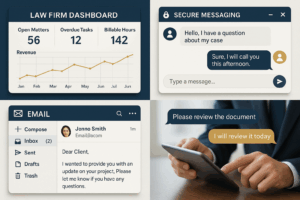Law Firms, Talk to Me: Inside the Client‑Communication Revolution

By Legal Attorney
The Silence That Costs Millions
When Kimberly L., a New York tech‑startup GC, hired outside counsel for a routine licensing spat, she expected—at the very least—an update every week. Instead, three silent months later, she learned via docket alert that opposing counsel had filed (and won) a motion to compel. Her reaction was swift and expensive: she fired the firm, hired new counsel, and tweeted a warning to her 40,000 followers. The price of that blackout? A bruised brand, a malpractice claim, and an ex‑client who will never return.
Kimberly’s story isn’t rare. “Failure to communicate” is still the single biggest reason clients abandon, sue, or grieve their lawyers [4]. What is rare—at least historically—is a profession willing to overhaul the way it talks to those clients. That is changing, fast.
1. The Communication Gap
“Regular communication with clients will minimize the occasions on which a client will need to request information.” —ABA Model Rule 1.4, Comment 4 [1]
Yet the gap between duty and reality yawns wide:
| Metric | What Clients Expect | What Firms Deliver |
|---|---|---|
| Response to first inquiry | 79 % within 24 h [2] | 60 % of firms never emailed back; 56 % never answered the phone [2] |
| Ongoing updates | “Reasonably informed” & clear next steps [1] | 82 % of clients have dumped a firm for poor updates [4] |
| Channel preference | Email, phone, text, portal | 67 % of firms still ignore new‑client emails [13] |
The numbers tell a brutal story: firms that don’t modernize their client comms bleed.
2. Why the Stakes Skyrocketed
-
Ethics got teeth. Model Rule 1.4 now underpins many state‑bar grievances for “black‑hole” silence [1], and regulators routinely cite it in disciplinary opinions [15].
-
Clients became consumers. A 2023 Thomson Reuters survey found 90 % rank “responsiveness” as the deciding factor when hiring counsel [5].
-
Everything went remote. COVID forced Zoom hearings, e‑signatures, and asynchronous video updates. The genie won’t go back in the bottle.
3. Tooling Up: The New Communication Stack
Legal‑Centric CRMs at a Glance
| Small–Mid Firms | Core Strength | Enterprise Firms | Core Strength |
|---|---|---|---|
| Clio Grow | Intake + drip automations | InterAction (LexisNexis) | Relationship intelligence |
| Lawmatics | Marketing workflows | Intapp DealCloud | Firm‑wide data/AI insights [12] |
| Law Ruler | SMS + PI‑specific intake [11] | Salesforce (customized) | Scalability, cross‑unit BD |
 Why it matters: A CRM turns every call, email, or text into data—no more “Did we reply?” guesswork.
Why it matters: A CRM turns every call, email, or text into data—no more “Did we reply?” guesswork.
Portals & Secure Messaging
Client portals (Clio for Clients, MyCase, etc.) let users fetch filings, pay invoices, or DM counsel 24/7, all behind encryption [6]. Portals cut “Where’s my document?” calls by up to 40 % according to Clio benchmarking [6].
Texting, But Make It Ethical
Platforms such as Kenect route SMS through a firm number, log every message to the matter file, and can even push instant pay links—tripling Google reviews in the process [8].
4. Multichannel Mastery
Phone for empathy. Email for depth. Text for urgency. Video for connection. The best firms ask clients up front: “How do you like to hear from us?” then build SOPs to match.
Block Quote
“Clients judge you by how quickly you answer, not how quickly you solve the problem. A 10‑minute callback beats a 10‑day miracle.” —Jim Calloway, Oklahoma Bar Practice Management
5. Automate the Boring, Humanize the Hard
-
Drip sequences: file‑stamped? Trigger a templated “What happens next” email.
-
Reminder bots: 48‑hour SMS nudge before hearings.
-
AI assistants: Draft first‑pass status texts (“Your deposition transcript arrived…”) for lawyer review.
Clio’s 2024 survey shows firms using automation grew revenue 30 % faster than those who didn’t—because lawyers spent the time on higher‑touch conversations, not copy‑paste jobs.
6. Seven Deadly Sins of Client Comms
-
Ghosting
-
Legalese overload
-
Overpromising outcomes
-
Ignoring preferred channels
-
Breaching confidentiality (e.g., CC’ing wrong party)
-
No written follow‑up
-
Surprise invoices
Avoid them and your NPS soars; commit them and you meet the grievance committee.
7. The Road Ahead
-
Voice‑activated portals: Clients will ask Alexa, “What’s the status of my case?” and the firm’s system will answer.
-
Hyper‑personal dashboards: Real‑time matter KPIs for GCs, visible like package tracking.
-
AI translation: Instant plain‑English (or Spanish) versions of every filing.
-
Predictive empathy: CRMs flag anniversaries, stress points, even client sentiment.
Endnotes
-
American Bar Association, “Model Rule 1.4: Communications.” American Bar Association
-
Clio, 2019 & 2022 Legal Trends Reports (response‑time data). Clio
-
Clio press release, “Law Firms Struggle to Respond to Client Inquiries.” Clio
-
CaseStatus, “What Do Lawyers Spend Their Time Doing?” (82 % attrition stat). casestatus.com
-
Thomson Reuters, Future Ready Lawyer 2023 survey (90 % responsiveness). Embroker
-
Clio, “Guide to Law‑Firm Client Portals” (portal benefits). Clio
-
Clio, “Guide to Better Law‑Firm Client Communication.” Clio
-
Kenect, “How Law Firms Use Text Messaging” (SMS + reviews). kenect.com
-
LexisNexis, “InterAction+ CRM.” LexisNexis
-
Lawmatics, pricing/features overview (automation workflows). lawmatics.com
-
Law Ruler, “Personal Injury Law Software” (PI‑specific CRM). Law Ruler
-
Intapp, “DealCloud for Legal—More Than a CRM” (enterprise AI/BD). Intapp
-
Clio, “Art of Client‑Centered Communication” (67 % no‑reply stat). Clio
-
LawNext, “AI Adoption by Legal Professionals Jumps to 79 %.” LawSites
-
ABA, “The Effective Lawyer: Communication & Competence” (disciplinary context). American Bar Association

